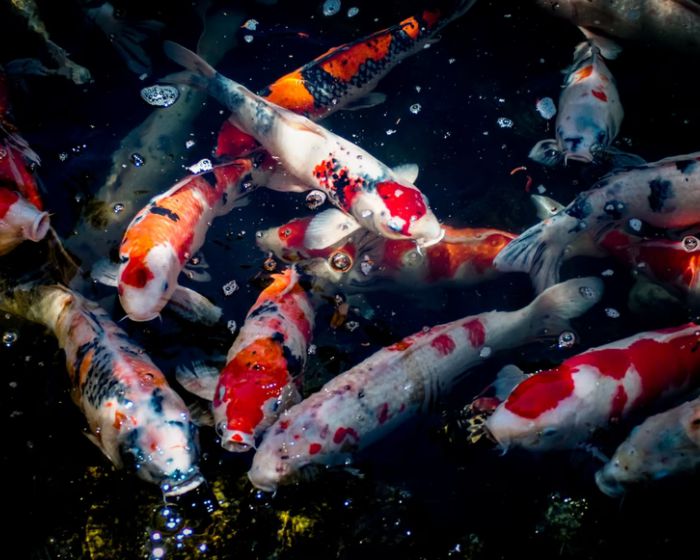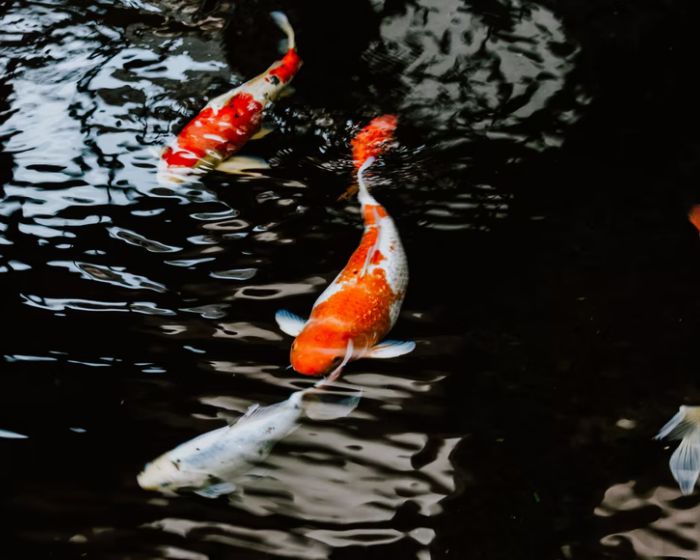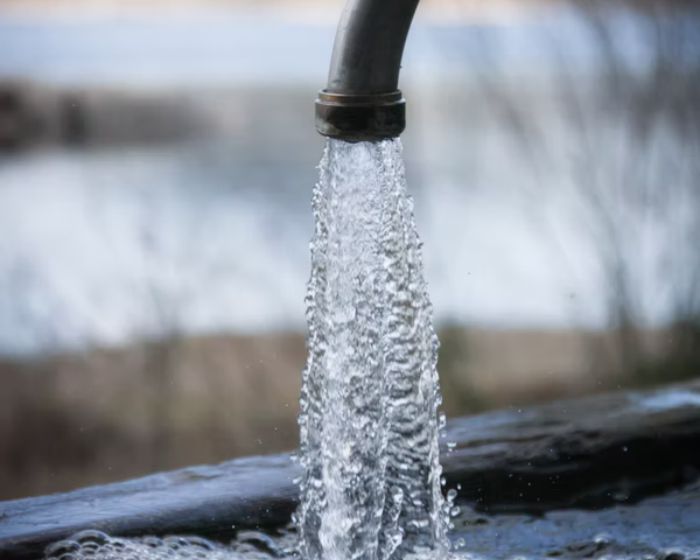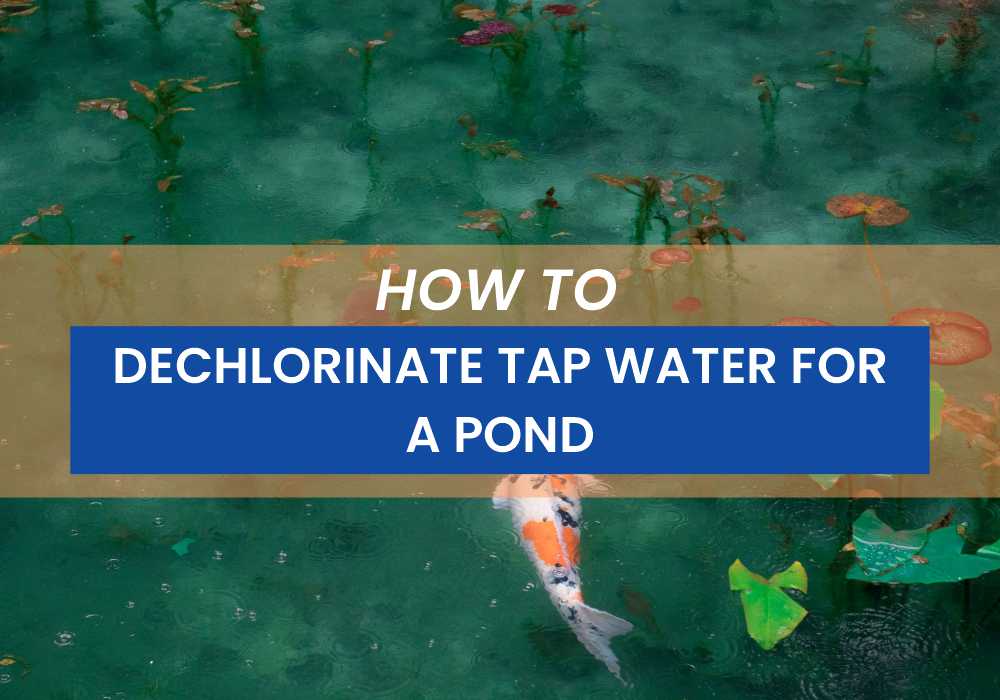As an Affiliate, We may earn a commission that doesn't cost you extra from qualifying purchases using links in this post. It helps keeps this blog running.
Keeping koi pond water clean with partial water changes is a top priority for koi pond owners. The koi fish population relies on clean koi pond water to survive, and if not managed well the koi will become weak and die.
In order to create an environment where koi can thrive pond owners need to have a good balance of koi pond plant life, koi pond fish population, koi pond water filtration, koi pond sanitation, and koi pond food.
Not only does frequently changing koi fish pond water naturally keep the koi pond new water soft but also reduces “pond scum”, kills bacteria with the natural byproduct of oxygenation, and eliminates odors. It makes ponds clean, clear, and healthy without stressing koi fish.
How Often Should You Change The Water In A Koi Pond? (Koi Pond Water Change Frequency)
Most new koi pond owners often ask themselves “how often should I change the water in my pond” what they do not know is that to keep their pond looking its best without using a water conditioner, it is important to change at least 10-15% of small ponds partial water weekly. Larger ponds may require more frequent water change depending on their size; 5%-10% will do just fine to reduce ammonia levels for 5000 gallons or above!
Frequently changing koi fish pond water is very important to the well-being of the fish in the pond because koi fish constantly produce a toxin called ammonia through their waste. These ammonia levels need to be cleaned out of the pond water frequently before it is able to build up and harm or kill the fish. The Koi fish Ammonia waste builds up faster during the summer when water evaporates so it’s important to change often as the fishes are better with clean water, but make sure that the water is in accordance with koi living conditions.
My recommendation for a great Pond water ammonia removal that will keep your fish alive is the API AMMO-LOCK Freshwater and Saltwater Aquarium Ammonia Detoxifier which also eliminates fish stress caused by ammonia.
Some people think changing old pond water to new water isn’t necessary, they believe it is not just part of koi pond maintenance. But koi fish can’t stay in the same pond water for too long because it will affect their health seriously. Not cleaning out the dirty water and replacing it with fresh, oxygenated one will cause harmful bacteria to build up in your koi’s pond which might hurt the fish’s health or even kill them. Not just that, it can also contribute to the growth of green algae which will no doubt add to the common problems.
How To Change A Koi Pond Water (The Best Guide)
As mentioned before, changing koi pond water is really important for the fish’s health and it needs to be done at least once in two weeks. Just like an aquarium with goldfish and other fish, a pond is a closed system of water that will eventually become filled with organic and inorganic substances including chemical pollutants. This leads to background pollution as well as poor water quality for fish; they can’t swim around in this closed system without being threatened by environmental changes caused by human interference. If not properly maintained, pond water quality will change in a short period of time.
To change your koi fish pond water follow the best guide below:
1) Drain Koi Pond Water
You will first need to open up your koi pond and drain it of all the water. Make sure that you change them as often as possible because you wouldn’t want your koi fish swimming in dirty or stagnant water.
My recommendation for a great Pond water drain is the Yescom 1/2 HP Submersible Water Pump which has a built-in auto-float switch that turns on the pump automatically when the water level rises above the predefined pump level, and also automatically disconnects when the pump fails which helps prevent the coil from getting burned.
2) Clean Water Features
To further increase your chance of getting water clarity – after emptying the pond, you can now go ahead and clean the different features inside it. This includes cleaning any filters that are present in your system. If you have a fountain or waterfall then these should also be taken care of for they certainly would have collected too much sludge if your last change was close to two weeks ago. Any gravel should also be removed for this will help drain out excess debris including dead leaves if there’s any present on them. Make sure that you change about 50% to 60%, this way it will make for a sufficient change.
3) Remove Dead Leaves and Sludge
Now that you have changed the gravel and cleaned the filters, it’s time to remove any dead leaves or fallen leaves inside your koi pond if there are any present before preparing for adding water back to the pond. This is also the time when you should drain your water feature of all excess sludge at its base; remember to change them as well around 50% to 60%. This is done by removing any surface scum, these could simply be removed using a garden hose or even better with a leaf rake. Now that you have gotten rid of much of the surface debris, it’s time to change about 10% of your pond water.
4) Refill the Pond Back with Clean Water
After having completed all previous tasks, you can now use a hose or pump to refill your koi pond back with clean tap water. If you’re using tap water then make sure that you change it first after 24 hours for this is done by putting in dechlorinating drops into them before adding them into your koi fish pond. The next step should be to check whether there are any leaks that could drain the koi pond water; if there are, then repairing them will be necessary. This should go without saying but ensure that you do not forget the be sure to change your filter cartridges as well.
5) Test Water Parameters
It’s a good idea to regularly test small water changes from your fish tank water for quality and clarity especially if it’s tap water. A few days before switching out the old with the new, or following an extensive change-out period (30 minutes up to 3 hours) after, are perfect times that will give you peace of mind knowing everything is still looking healthy!
5) Add Supplements and Chemicals Using a garden hose.
Go ahead and add any supplements as well as chemicals that you might need to use. Be sure to follow the instructions from previous users or from those who made these products.
Now that all of your changes have been done, it’s time to let them rest for about 48 hours so as to balance out the chemistry inside your koi fish pond. After a few days, you can now change another 10% using a hose or pump again. Make sure that once everything is stable then you change it at least every two weeks or even monthly if there aren’t any problems present already.
Above are the steps on how to change a koi fish pond water.
Is It Necessary To Change Koi Pond Water?
It is not only necessary, but it is also important to always change koi fish pond water, and one of the most important things to consider when raising koi is water changes. It was discovered that regular weekly or monthly water changes are necessary to get rid of chemical pollutants and enhance both growth and health, but there’s no one-size-fits-all strategy here, you just have to figure out what goals you want your fish to meet!
Factors such as the size of your koi pond, and the number of koi you have will greatly determine your schedule and routine of koi fish pond water changes.
When Should I Change My Pond Water?
This is one of the most commonly asked questions when it comes to koi pond maintenance. You should not do a complete pond water change periodically. Koi need time to adjust to different water conditions and changing the water every willy-nilly can do more harm than good.
The answer isn’t as simple as many people think. It’s not like changing the oil in your car where you can decide to change it every 3000 miles (or 3 months).
It’s best if you change a certain percentage of your pond water at regular times throughout the year while leaving some of the old water inside the pond at all times during this process.
Sometimes you wonder what time of year to change your koi pond water. Well, different people have different needs for this; some may change the water once a week and others might change it once a month or even less. There is no clear guide that says “change your pond water every 15 days” because everyone has different requirements and there are multiple factors that can alter these requirements. One main deciding factor is temperature; as colder temperatures mean more dissolved oxygen in the water, the fish require less food than if it were warmer as they expend less energy to maintain their body heat. Another thing is if you change your koi pond water frequently enough nitrate levels will not rise significantly and your fish are more healthy.
How Much Salt Should I Add To My Koi Pond?
The dosage varies from 0.3% to 0.6%, but I recommend you start with the lower amount and gradually raise it as needed for consistent use; this way your koi will be more comfortable and adapt easily!
The salt level can make up to 1kg (2 pounds) per 1000 liters of water, which would create approximately a solution at around .1%. I suggest starting off on these amounts: 30ml (.033 oz), 180m(59 ft.), etc., then going upward accordingly until it’s just right.
It is widely known that salt can be used to treat new, sick, or stressed koi. However, it should not come as a surprise when I tell you how this works because there are certain guidelines for adding the right amount to your pond! Too much of anything might seem like a good idea at first to most pond owners, but when applied too liberally- even healthy things turn out badly eventually. So before adding any kind of soluble substance into the fish ecosystem make sure you research thoroughly and understand its potential effects on other organisms present within their own individual ecosystems so they don’t end up harming them.
Should You Change Koi Pond Water In The Winter

If you’re wondering how often you should change the water during the winter months, there is no definite answer. One change a month is usually safe, but change the water whenever you think it’s also okay. A good rule of thumb though: change your koi pond’s water once every two to three months during the winter and change the water as needed during colder conditions (if you notice any ice on top of your pond, change it immediately as this will greatly destabilize the pond water temperature).
As cool weather finally sets in and the pond water temperature keeps dropping, you may think that you need to change their water like other pets such as dogs and cats would change theirs. However, pet owners do not change their dog or cat’s water in the winter because their metabolism slows down – which leads to less urination.
The same thing happens with koi fish; even though the pond’s temperature drops, so does their appetite and metabolic rate (calories burned). Koi continue eating the same amount of food as they would in the summer, even though less energy is burned up. All fish change their metabolism to match the environment at certain times throughout the year – during winter months, koi change by lowering their metabolic rate to conserve energy.
Keeping the water temperature of your pond at approximately 50 degrees Fahrenheit (10 Celsius) will help keep your fish healthy and happy all year long!
Generally speaking, change the water in summer when water evaporates a lot before autumn and change the water between spring and summer. During the winter months, regular water changes are less important because lower temperatures have little impact on fish metabolism.
So if your koi behave normally, feeling active or hungry throughout winter, there is no reason to change their water.
Conclusion
Adding water to a pond shouldn’t be difficult, and regular water changes in your koi fish pond are important, regardless of whether they’re indoors or outdoors. It only takes about 30 minutes to change the tiniest amount of water, but it can prolong their life expectancy by years!
When you change your koi’s water, make sure you apply dechlorinator (make sure to follow instructions on the product on how much you need) and replace it with clean water (preferably at the same temperature as the one currently inside your pond). This way, nothing bad will happen to them due to a change in temperature or chemicals because everything is going to be balanced out so there’ll be no problems for them.

I’m Akin Bouchard. Even though I now own several different fish species, I first became a koi pond owner because I loved these creatures and wanted to turn my passion into something more serious. I take pride in my collection of koi fish and love sharing my knowledge with others interested in these beautiful creatures.
A Comprehensive Guide to Training Your Fish to Perform Amazing Tricks Feats




